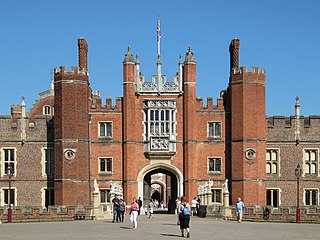
Hampton Court Palace is a Grade I listed royal palace in the London Borough of Richmond upon Thames, 12 miles southwest and upstream of central London on the River Thames. Opened to the public, the palace is managed by Historic Royal Palaces, a charity set up to preserve several unoccupied royal properties.

John Beaufort, 1st Marquess of Somerset and 1st Marquess of Dorset, later only 1st Earl of Somerset, was an English nobleman and politician. He was the first of the four children of John of Gaunt (1340–1399) by his mistress Katherine Swynford, whom he later married in 1396.
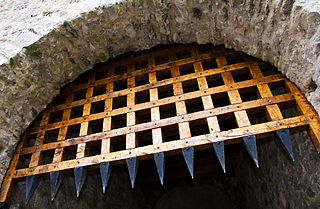
A portcullis is a heavy, vertically closing gate typically found in medieval fortifications, consisting of a latticed grille made of wood and/or metal, which slides down grooves inset within each jamb of the gateway.

The coat of arms of the United Kingdom are the arms of dominion of the British monarch. They are both the personal arms of the monarch, currently King Charles III, and the arms of the state. In addition to the monarch, the arms are used by state institutions including the Government of the United Kingdom, the Parliament of the United Kingdom, and the British judiciary. Differenced versions of the arms are used by members of the British royal family. The monarch's official flag, the Royal Standard, is the coat of arms in flag form.

The coat of arms of England is the coat of arms historically used as arms of dominion by the monarchs of the Kingdom of England, and now used to symbolise England generally, but not officially. The arms were adopted c.1200 by the Plantagenet kings and continued to be used by successive English and British monarchs; they are currently quartered with the arms of Scotland and Ireland in the coat of arms of the United Kingdom. Historically they were also quartered with the arms of France, representing the English claim to the French throne, and Hanover.

The Tudor rose is the traditional floral heraldic emblem of England and takes its name and origins from the House of Tudor, which united the House of Lancaster and the House of York. The Tudor rose consists of five white inner petals, representing the House of York, and five red outer petals to represent the House of Lancaster.
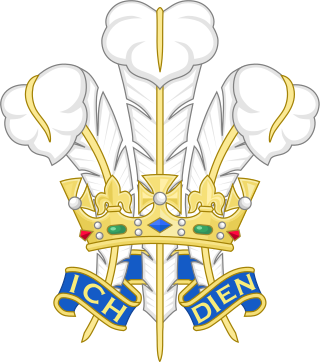
A heraldic badge, emblem, impresa, device, or personal device worn as a badge indicates allegiance to, or the property of, an individual, family or corporate body. Medieval forms are usually called a livery badge, and also a cognizance. They are para-heraldic, not necessarily using elements from the coat of arms of the person or family they represent, though many do, often taking the crest or supporters. Their use is more flexible than that of arms proper.
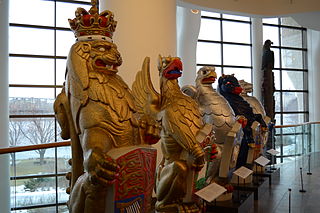
The Queen's Beasts are ten heraldic statues representing the genealogy of Queen Elizabeth II, depicted as the Royal supporters of England. They stood in front of the temporary western annexe to Westminster Abbey for the Queen's coronation in 1953. Each of the Queen's Beasts consists of a heraldic beast supporting a shield bearing a badge or arms of a family associated with the ancestry of Queen Elizabeth II. They were commissioned by the British Ministry of Works from the sculptor James Woodford, who was paid the sum of £2,750 for the work. They were uncoloured except for their shields at the coronation. They are now on display in the Canadian Museum of History in Gatineau, Quebec.

A Royal Badge for Wales was approved in May 2008. It is based on the arms borne by the thirteenth-century Welsh prince Llywelyn the Great, with the addition of St Edward's Crown atop a continuous scroll which, together with a wreath consisting of the plant emblems of the four countries of the United Kingdom, surrounds the shield. The motto which appears on the scroll, PLEIDIOL WYF I'M GWLAD, is taken from the National Anthem of Wales and is also found on the Welsh designs for £1 coins minted from 1985 until 2000. The badge formerly appeared on the covers of Assembly Measures; since the 2011 referendum, it now appears on the cover of Acts passed by the Senedd and its escutcheon, ribbon and motto are depicted on the Welsh Seal.
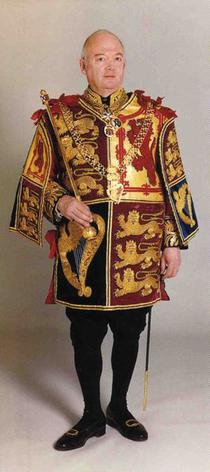
John Philip Brooke Brooke-Little was an English writer on heraldic subjects, and a long-serving herald at the College of Arms in London. In 1947, while still a student, Brooke-Little founded the Society of Heraldic Antiquaries, now known as the Heraldry Society and recognised as one of the leading learned societies in its field. He served as the society's chairman for 50 years and then as its president from 1997 until his death in 2006.

The House of Beaufort is an English noble and quasi-royal family which originated in the fourteenth century as the legitimated issue of John of Gaunt, 1st Duke of Lancaster by Katherine Swynford. Gaunt and Swynford had four children: John Beaufort, 1st Earl of Somerset (1373–1410); Cardinal Henry Beaufort, (1375–1447), Bishop of Winchester; Thomas Beaufort, 1st Duke of Exeter (1377–1426) and Joan Beaufort, Countess of Westmorland (1379–1440). When Gaunt finally married Swynford as his third wife in 1396, the Beauforts were legitimized by Pope Boniface IX and by royal proclamation of the reigning monarch King Richard II the following year.

The White Greyhound of Richmond is one of the Queen's Beasts commissioned for display at the coronation of Queen Elizabeth II in 1953. A stone copy can also be found in the Royal Botanic Gardens, Kew.

The royal standards of England were narrow, tapering swallow-tailed heraldic flags, of considerable length, used mainly for mustering troops in battle, in pageants and at funerals, by the monarchs of England. In high favour during the Tudor period, the Royal English Standard was a flag that was of a separate design and purpose to the Royal Banner. It featured St George's Cross at its head, followed by a number of heraldic devices, a supporter, badges or crests, with a motto—but it did not bear a coat of arms. The Royal Standard changed its composition frequently from reign to reign, but retained the motto Dieu et mon droit, meaning God and my right; which was divided into two bands: Dieu et mon and Droyt.

English heraldry is the form of coats of arms and other heraldic bearings and insignia used in England. It lies within the so-called Gallo-British tradition. Coats of arms in England are regulated and granted to individuals by the English kings of arms of the College of Arms. An individual's arms may also be borne 'by courtesy' by members of the holder's nuclear family, subject to a system of cadency marks, to differentiate those displays from the arms of the original holder. The English heraldic style is exemplified in the arms of British royalty, and is reflected in the civic arms of cities and towns, as well as the noble arms of individuals in England. Royal orders in England, such as the Order of the Garter, also maintain notable heraldic bearings.

St George's Chapel at Windsor Castle in England is a castle chapel built in the late-medieval Perpendicular Gothic style. It is a Royal Peculiar, and the Chapel of the Order of the Garter. St George's Chapel was founded in the 14th century by King Edward III and extensively enlarged in the late 15th century. It is located in the Lower Ward of the castle.
The royal supporters of England are the heraldic supporter creatures appearing on each side of the royal arms of England. The royal supporters of the monarchs of England displayed a variety, or even a menagerie, of real and imaginary heraldic beasts, either side of their royal arms of sovereignty, including lion, leopard, panther and tiger, antelope and hart, greyhound, boar and bull, falcon, cock, eagle and swan, red and gold dragons, as well as the current unicorn.

In heraldry, the royal badges of England comprise the heraldic badges that were used by the monarchs of the Kingdom of England.

Edward Earle Dorling was a priest of the Church of England, archaeologist, historian, and notable writer on heraldry.

The coat of arms of the Prince of Wales is the official personal heraldic insignia of the Princes of Wales, a title traditionally granted to the heir apparent of the reigning monarch of the United Kingdom of Great Britain and Northern Ireland, formerly the Kingdom of Great Britain and before that the Kingdom of England.

Galyon Hone was a glazier from Bruges who worked for Henry VIII of England at Hampton Court and in other houses making stained glass windows. His work involved replacing the heraldry and ciphers of Henry VIII's wives in windows when the king remarried.





































